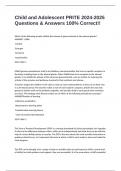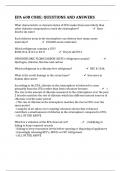Child and Adolescent PRITE 2024-2025
Questions & Answers 100% Correct!!
Which of the following acutely inhibits the release of glucocorticoids in the adrenal glands? -
ANSWER* GABA
Cortisol
Estrogen
Serotonin
Acetylcholine
2019 Child: 1
GABA (gamma-aminobutyric acid) is an inhibitory neurotransmitter that acts on specific receptors in
the body, including those in the adrenal glands. When GABA binds to its receptors in the adrenal
glands, it can inhibit the release of the hormone glucocorticoids, such as cortisol, by reducing the
activity of the enzymes and pathways involved in their synthesis and release.
A teacher assigns the children in the class to solve as many math problems as they can on their own
in a 20-minute period. The teacher makes a note of each student's progress, divides the class into
groups to further work on the problems together, and provides help to each group when members
are stuck. This strategy most directly makes use of which of the following educational concepts? -
ANSWERTransfer of learning
Collective socialization
Attunement to learning styles
Transformative learning theory
* Zone of proximal development
2019 Child: 2
The Zone of Proximal Development (ZPD) is a concept developed by Soviet psychologist Lev Vygotsky.
It refers to the difference between what a child can do independently and what they can do with the
help of a more skilled partner or teacher. The ZPD is the area where the most sensitive instruction or
guidance should occur, as it represents the level at which a child is most ready to learn and make the
most progress.
The ZPD can be thought of as a range of tasks or activities that are just beyond a child's current level
of ability, but with guidance and support, they can accomplish. It is the area where a child's potential
,for learning and development is the highest. Vygotsky believed that the ZPD is critical in the
development of cognitive and social skills and that it can be used as a guide for instructional planning
By age three years, toddlers can typically perform which of the following tasks? - ANSWERTie
shoelaces
Fasten buttons
Close a zipper
* Manipulate scissors
Draw a person with realistic proportions
2019 Child: 3
Traditional psychodynamic therapy is a longer-term treatment that usually involves weekly sessions
over a period of several months or even years. The focus of traditional psychodynamic therapy is on
exploring the patient's unconscious thoughts, feelings, and behaviors that may be contributing to
their current problems. This therapy aims to help the patient gain insight and understanding into
their problems and how they developed, and how to change their maladaptive ways of thinking,
feeling and behaving.
Short-term psychodynamic therapy, on the other hand, is usually a more focused and time-limited
treatment that may last for several weeks or months. The focus of short-term psychodynamic
therapy is on addressing specific, well-defined problems or symptoms that the patient is
experiencing. This therapy aims to help the patient identify and understand the underlying causes of
their problems, but also providing them with specific techniques or strategies to cope with them in
the short term.
In summary, traditional psychodynamic therapy is a longer-term treatment that focuses on exploring
the patient's unconscious thoughts, feelings, and behaviors, while short-term psychodynamic
therapy is a more focused and time-limited treatment that addresses specific problems or symptoms.
During a psychiatric evaluation, which of the following methods would best help develop the
therapeutic alliance between a psychiatrist and a new immigrant patient and family? -
ANSWERConsulting with the immigrant family's traditional healers
Conducting the initial appointment with the identified patient only
Relying on previous clinical experiences with this immigrant population
* Using a qualified interpreter who has proficiency in the family's language of origin
Maintaining consistent individualistic boundary practices across the spectrum of cultures
2019 Child: 5
Children typically demonstrate the most overt sexual interest and behavior during which of the
following developmental stages? - ANSWERInfancy
Toddlerhood
* Preschool
,Early school-age
Late school-age
2019 Child: 6
Research on typical development has focused on the acquisition of language as a foundation for
cognitive and other areas of development. Which of the following has been demonstrated to be
most significantly related to language proficiency in preschoolers in the United States? -
ANSWERParental age
Geographical location
* Socioeconomic status
Parental native language
Contact with other children
2019 Child: 7
Socioeconomic status (SES) is closely related to language proficiency in preschoolers in the United
States. Research has shown that children from low-SES backgrounds are more likely to have lower
levels of language proficiency than children from higher-SES backgrounds. This can be due to a
number of factors, including differences in access to quality early childhood education, exposure to
language and literacy at home, and parenting practices that support language development.
Children from low-SES backgrounds are more likely to attend preschools that have fewer resources
and less qualified teachers, and they may not have the same opportunities to learn and practice
language as children from higher-SES backgrounds. Additionally, children from low-SES backgrounds
are more likely to be exposed to fewer books, educational toys, and other materials that promote
language development. They also may not have the same opportunities to interact with adults and
older children who can help them learn new words and concepts.
Furthermore, parents from low-SES backgrounds may have less education and be less likely to
engage in activities that promote language development such as reading to their children, telling
them stories, or engaging them in conversation.
It is important to note that this does not mean that all children from low-SES backgrounds will have
lower language proficiency, but rather that children from low-SES backgrounds are more likely to
have lower language proficiency than children from high-SES backgrounds. Also, early intervention
programs and policies that aim to provide children from low-SES backgrounds with more
opportunities to learn and practice language can help to close this gap.
A youth who has been on long-term risperidone treatment develops tardive dyskinesia which
continues despite initially reducing the dose, and then sequential optimal trials of aripiprazole,
olanzapine and quetiapine, each for sufficient duration and dose. The most appropriate next step is
to start which of the following treatments? - ANSWER* Switch neuroleptic to clozapine
Add Vitamin E to neuroleptic use
Switch neuroleptic to fluphenazine
, Add benztropine to neuroleptic use
Add botulinum toxin injections to neuroleptic use
2019 Child: 8
Clozapine is less likely to cause extrapyramidal symptoms (EPS) than other atypical antipsychotics
because it has a lower binding affinity for dopamine receptors in the brain. EPS are side effects of
antipsychotic medications that can include movement disorders such as tremors, stiffness, and
difficulty with coordination. These symptoms are caused by the blockade of dopamine receptors in
the brain, which can occur with medications that bind strongly to these receptors. Clozapine has a
lower binding affinity for dopamine receptors than other antipsychotics, which means that it is less
likely to cause EPS. Additionally, Clozapine has a unique property of binding to multiple receptors in
the brain, which may reduce its EPS-inducing properties.
Extrapyramidal symptoms (EPS) are primarily associated with the blockade of dopamine receptors in
the basal ganglia, which is a specific pathway in the brain that plays a key role in motor control and
coordination. The basal ganglia is composed of several structures, including the striatum, globus
pallidus, and substantia nigra. The striatum is the primary input nucleus of the basal ganglia and
receives dopaminergic input from the substantia nigra. The globus pallidus and substantia nigra are
the main output nuclei of the basal ganglia and are involved in the regulation of muscle tone and
movement. When dopamine receptors in the basal ganglia are blocked, it can disrupt the normal
functioning of this pathway and lead to EPS such as akathisia, parkinsonism, and dystonia.
By age three years, toddlers typically have developed the fine motor skills necessary to perform a
variety of tasks such as:
· Manipulating scissors: They can hold and open and close scissors with one hand and make basic
cutting motions.
· Drawing and coloring: They can hold a crayon, marker or pencil with a mature grip and make marks
on paper.
· Building with blocks: They can stack blocks, build towers and make simple structures.
· Stringing beads: They can thread large beads on a string or lace.
· Turning pages in a book: They can turn pages one at a time with thumb and index finger.
· Dressing themselves: They can dress and undress themselves with some assistance.
· Brushing their teeth: They can brush their teeth with some assistance.
· Using utensils: They can use a fork and spoon with some assistance and may start using a knife to
cut soft foods.
It's important to note that children develop at different rates, so some children may be able to
perform these tasks earlier or later than others.





